Introduction
The “DOGE stimulus check 2025” has been a popular topic among US taxpayers, driven by rumors of a possible $5,000 payment from the Department of Government Efficiency (DOGE). Intended as a “DOGE Dividend,” the refund would return savers from federal budget reductions to paying tax families. Once advocated for by Elon Musk and signed into law by President Donald Trump, the proposal guaranteed substantial financial aid. But with the exit of Musk from DOGE and persistent issues, the DOGE stimulus check is still a question mark. This post offers an in-depth overview of the DOGE stimulus check in 2025, including its inception, qualification, status, and what taxpayers can look forward to in the future.

What Is the DOGE Stimulus Check 2025?
The DOGE stimulus check, also referred to as the DOGE Dividend, is a suggested tax rebate program associated with the Department of Government Efficiency (DOGE), an advisory task force formed by President Trump on January 20, 2025, to cut federal expenditures. The concept, originally presented by James Fishback, Azoria Investments CEO, recommends reducing 20% of DOGE’s savings realized through contract cancellations, employee cuts, and cancellation of fraudulent activities to taxpayers. With a target of $2 trillion in savings by July 2026, Fishback calculated that 20% ($400 billion) would equate to $5,000 for each tax-paying household based on 79 million eligible households.
In contrast to deficit-funded COVID-19 stimulus payments, the DOGE Dividend would only be paid from confirmed savings, seeking to prevent inflationary effects. Yet, as of June 2025, the proposal is yet to be approved, and DOGE’s savings assertion is under fire for discrepancies.
Origins of the DOGE Stimulus Check Concept
The idea of a DOGE stimulus check came about in February 2025 when Fishback tweeted on X, calling upon Trump and Musk to declare a “DOGE Dividend” to bring back taxpayer funds saved by DOGE’s cost-saving initiatives. Musk reacted with, “Will check with the President,” and there was universal interest. Trump endorsed the idea at the FII PRIORITY Summit in Miami on February 19, 2025, stating, “We’re considering giving 20% of the DOGE savings to American citizens and 20% to paying down the debt.”
Fishback’s four-page proposal on MyDogeDividend.com described a taxpaying family refund, contending that taxpayers fund 70% of government spending and that the dividend is a payback. The proposal resonated with Republicans, who supported it in a J.L. Partners survey by 60%, as opposed to 39% of Democrats and Independents. Yet, no bill has been enacted and remains hypothetical.
Eligibility for the DOGE Stimulus Check 2025
Fishback’s plan aims at families that pay federal income tax, but not low-income families who receive tax credits or owe no taxes. It is unlike COVID-era stimulus checks, which were issued more universally. Major eligibility information includes:
Eligible Households:
Roughly 79 million American households that file and pay federal income taxes, including Social Security recipients who earn within income tax limits.
Exclusions:
Non-taxpaying households, such as those with adjusted gross incomes below $40,000 (who often pay no federal income tax), and undocumented immigrants. Fishback emphasized, “Illegal immigrants are never going to get a penny,” citing their lack of federal tax contributions.
Employment Consideration:
Fishback suggested tying eligibility to employment to incentivize workforce participation, though this isn’t finalized.
Eligibility is speculative until Congress OKs the plan. Taxpayers should check their tax status with a professional.
Current Status of the DOGE Stimulus Check 2025
Through June 17, 2025, the DOGE stimulus check remains a proposal, with no checks mailed. Here’s the update:
DOGE Savings Claims:
DOGE claims $180 billion in savings, of which $34 billion is from 11,042 contract cancellations, $44 billion from 15,198 grant cancellations, and $211 million from 485 lease cancellations. Yet DOGE has only $70.9 billion listed on its “Wall of Receipts,” and outside estimates put actual savings at $35–80 billion after deducting $135 billion in expense from lost productivity and lawsuits.
Musk Exit:
Musk departed DOGE in late May 2025, as a result of the 130-day special government employee limitation and disagreements with his enterprises, such as Tesla and SpaceX. His departure, along with his top advisors, has cooled support for the dividend.
Legislative Challenges:
Congressional approval, not proposed, is needed for the stimulus. House Speaker Mike Johnson and fellow Republicans have questioned it, citing risk of inflation.
Economic Issues:
Economists such as Jay Zagorsky caution that $400 billion in checks would feed inflation, as with COVID stimulus effects. Others, such as Elaine Kamarck, label the plan “ridiculous” because of a lack of adequate savings.
In terms of existing savings of $115 billion, each taxpayer would be eligible for around $142 if payments were made today, well short of the $5,000 goal.
Why Is the DOGE Stimulus Check Controversial?
1. Unsubstantiated Savings
DOGE’s $180 billion savings estimate has mistakes, including a triple-counted $655 million contract and an $8 billion contract incorrectly reported as $8 million. NPR and WHYY found that almost 40% of the canceled contracts won’t save anything, making the plan less viable.
2. Inflation Risks
Critics, such as Sarah Maitre and Judge Glock, caution that handing out billions may fuel inflation, particularly in the context of Trump’s tariff policies. Fishback contends the checks won’t be inflationary as they’re being paid for from savings, not borrowing, but economists are skeptical.
3. Impact on Services
DOGE’s reductions, in the form of agency layoffs such as those at USAID and the Department of Education, have caused worry over decreased services, e.g., veterans’ care or disaster relief. The Partnership for Public Service has estimated $135 billion in costs of these disruptions.
4. Political Motivations
Critics such as Brendan Duke contend that the dividend is a political move to increase Trump’s popularity, not a fiscal reform. Misleading statements, such as Musk’s suggestion of $2.7 trillion in fraudulent Medicaid payments, have been discredited, further undermining confidence.
Alternatives to the DOGE Stimulus Check
As the DOGE Dividend hangs in the balance, some states are sending their own relief payments in 2025:
-
New York: Single filers with income up to $150,000 qualify for $300 inflation rebates, and joint filers with incomes up to $300,000 are qualified for $500 rebates, which started in April 2025.
-
California: Up to $725 Golden State Stimulus checks are available to qualified residents, with priority given to those who were missed in previous rounds.
-
Colorado: TABOR payments of $800 for single filers and $1,600 for joint filers are funded by a $1.5 billion surplus.
Verify at state government websites for payment schedules and eligibility.
Staying Informed
To follow DOGE stimulus check news:
-
Visit Official Websites: Check for savings claims at doge.gov but cross-check with news sources such as Newsweek or NPR for authenticity.
-
Follow IRS Updates: The IRS has not approved DOGE checks. Go to irs.gov for tax updates.
-
Follow X Discussions: X posts mirror public interest but are usually evidence-free. For instance, @daveweigel stated there is no plan for $5,000 checks.
-
Avoid Scams: Avoid fake websites or emails purported to provide DOGE checks. Only use authentic sources.
FAQs Regarding the DOGE Stimulus Check 2025
1. Will there be a DOGE stimulus check in 2025?
As of June 2025, no checks are certain. Congressional approval is required for the proposal, which has not been introduced.
2. How much might the DOGE Dividend be?
The amount proposed is $5,000 per family, but current savings would provide only $142 per taxpayer if issued now.
3. Who would receive the DOGE stimulus check?
Only families who pay federal income tax would qualify, not non-taxpayers or illegal immigrants.
4. When might checks be issued?
Fishback suggested July 2026, but there is no deadline because of legislative holds.
Conclusion
The DOGE stimulus check 2025 is a tempting but unconfirmed proposal. Although the concept of a $5,000 DOGE Dividend has caught the imagination of the people, issues such as unverifiable savings, Musk’s resignation, and Congressional inaction raise questions about its feasibility. Taxpayers should be realistic, watch out for reliable news, and beware of scams that promise payments. As DOGE goes on its way, its influence on federal spending and services will determine if this ambitious refund plan is actualized. In the meantime, consider state-level relief measures and seek advice from tax professionals for individualized guidance.
